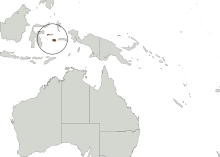
Sulawesi, also known as Celebes, is an island in Indonesia. One of the four Greater Sunda Islands, and the world's eleventh-largest island, it is situated east of Borneo, west of the Maluku Islands, and south of Mindanao and the Sulu Archipelago. Within Indonesia, only Sumatra, Borneo, and Papua are larger in territory, and only Java and Sumatra have larger populations.

The North Sulawesi babirusa is a pig-like animal native to Sulawesi and some nearby islands in Indonesia. It has two pairs of large tusks composed of enlarged canine teeth. The upper canines penetrate the top of the snout, curving back toward the forehead. The North Sulawesi babirusa is threatened from hunting and deforestation.

Wallacea is a biogeographical designation for a group of mainly Indonesian islands separated by deep-water straits from the Asian and Australian continental shelves. Wallacea includes Sulawesi, the largest island in the group, as well as Lombok, Sumbawa, Flores, Sumba, Timor, Halmahera, Buru, Seram, and many smaller islands. The islands of Wallacea lie between the Sunda Shelf to the west, and the Sahul Shelf including Australia and New Guinea to the south and east. The total land area of Wallacea is 347,000 km2 (134,000 sq mi).

The babirusas, also called deer-pigs, are a genus, Babyrousa, in the swine family found in the Indonesian islands of Sulawesi, Togian, Sula and Buru. All members of this genus were considered part of a single species until 2002, the babirusa, B. babyrussa, but following that was split into several species. This scientific name is restricted to the Buru babirusa from Buru and Sula, whereas the best-known species, the north Sulawesi babirusa, is named B. celebensis. The remarkable "prehistoric" appearance of these mammals is largely due to the prominent upwards incurving canine tusks of the males, which actually pierce the flesh in the snout.
The Sula Islands Regency is one of the regencies in North Maluku province of Indonesia. It covers a land area of 3,338.67 km2 and consists of two of the three large islands comprising the Sula Archipelago, together with minor adjacent islands. These two islands are Sulabesi and Mangoli. The third island, Taliabu, was split off from the Sula Islands Regency in 2013 to form a separate regency.

Lore Lindu National Park is a protected area of forest on the Indonesian island of Sulawesi, in the province of Central Sulawesi. The Indonesian national park is 2,180 km2 covering both lowland and montane forests. It provides habitat to numerous rare species, including 77 bird species endemic to Sulawesi. The national park is designated as part of the UNESCO World Network of Biosphere Reserves. In addition to its rich wildlife, the park also contains megaliths dating from before 1300 AD.

The Celebes warty pig, also called Sulawesi warty pig or Sulawesi pig, is a species in the pig genus (Sus) that lives on Sulawesi in Indonesia. It survives in most habitats and can live in altitudes of up to 2,500 m (8,000 ft). It has been domesticated and introduced to a number of other islands in Indonesia.
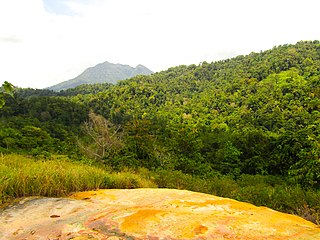
Bogani Nani Wartabone National Park is a 2,871 km2 (1,108 mi2) national park on Minahassa Peninsula on Sulawesi island, Indonesia. Formerly known as Dumoga Bone National Park, it was established in 1991 and was renamed in honour of Nani Wartabone, a local resistance fighter who drove the Japanese from Gorontalo during World War II. The park has been identified by Wildlife Conservation Society as the single most important site for the conservation of Sulawesi wildlife and is home to many species endemic to Sulawesi.

The dark-eared myza, also known as the lesser streaked honeyeater, is a species of bird in the family Meliphagidae. It is endemic to the island of Sulawesi in Indonesia. There are two subspecies, Myza celebensis celebensis which is found in mountainous parts of northern, central and southeastern Sulawesi, and Myza celebensis meridionalis from mountains in southern Sulawesi.
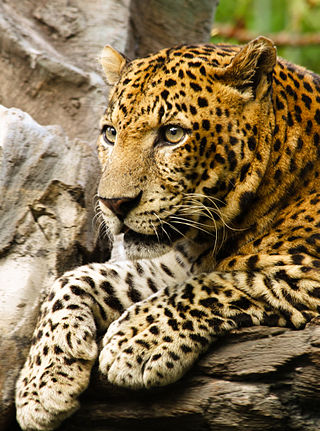
The Javan leopard is a leopard subspecies confined to the Indonesian island of Java. It has been listed as Endangered on the IUCN Red List since 2021. The population is estimated at 188–571 mature individuals in 22 fragmented subpopulations and a declining population trend. The total remaining habitat is estimated at only 2,267.9 to 3,277.3 km2.
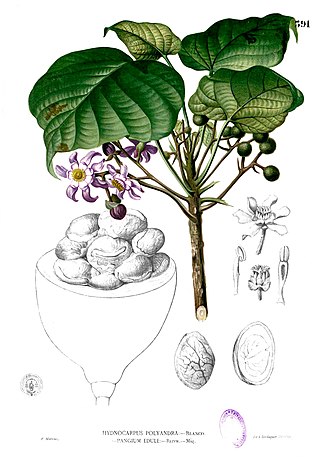
Pangium is a genus containing the sole species Pangium edule, a tall tree native to the mangrove swamps of Southeast Asia. It produces a large poisonous fruit which can be made edible by fermentation. It is dioecious, with male and female flowers produced on separate individuals.
Babyrousa bolabatuensis, the Bola Batu babirusa, is a species of babirusa from the Indonesian island of Sulawesi. It was first described in 1950 as a subspecies of Babyrousa babyrussa, then the only recognized species of babirusa, and raised to species rank by Colin Groves and Erik Meijaard in 2002. At present the Bola Batu babirusa is only known for certain from subfossil remains from the southern arm of Sulawesi. Based on a single skull from central Sulawesi it has been suggested that babirusas from this part of Sulawesi represent an extant population of the Bola Batu babirusa, and this was followed in the third edition of Mammal Species of the World. However, the most recent major review also found similarities between the central Sulawesi specimen and the Togian babirusa, leading them to conclude that it represents an undescribed taxon and that the taxonomic position of central Sulawesi babirusas only can be determined through additional specimens. Subfossil remains from the south-western arm of Sulawesi, where now likely extinct, have been classified as Bola Batu babirusas, but these were considered unclassifiable in 2002, as were extant populations from the eastern arm of Sulawesi and Buton due to the lack of specimens. Due to these uncertainties, the IUCN Red List provisionally synonymized B. bolabatuensis under the northern Sulawesi species, B. celebensis, pending clarification of the taxonomy of Sulawesi babirusas.

The Togian babirusa, also known as the Malenge babirusa, is the largest species of babirusa. It is endemic to the Togian Islands of Indonesia, but was considered a subspecies of Babyrousa babyrussa until 2002. Compared to the better-known north Sulawesi babirusa, the Togian babirusa is larger, has a well-developed tail-tuft, and the upper canines of the male are relatively "short, slender, rotated forwards, and always converge". The Togian babirusa is omnivorous, feeding mainly on roots and fallen fruit but also worms and invertebrates. Unlike other pig species, the Togian babirusa does not root at the ground with its snout when foraging, but instead can be seen pawing at the ground to uproot plants.
B. celebensis may refer to:
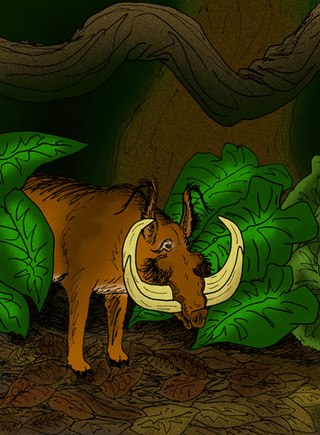
Celebochoerus is an extinct genus of giant suid artiodactyl that existed during the Pliocene and Pleistocene in Sulawesi, Indonesia, and the middle Pleistocene of Luzon, in the Philippines.

The Sulawesi lowland rain forests is a tropical moist forest ecoregion in Indonesia. The ecoregion includes the lowlands of Sulawesi and neighboring islands.

The Sulawesi montane rain forests is a tropical moist forest ecoregion in Indonesia. It includes the highlands of Sulawesi.

